Diane Caldwell
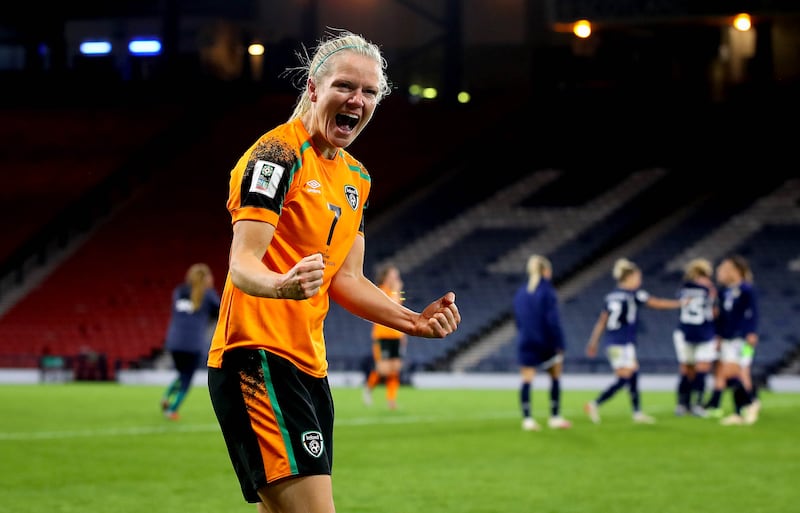
When she moved from New York to a small coastal town in northern Iceland in 2011, Diane Caldwell had plenty of time to reflect on her winding football journey as she travelled with her new team by coach to their games.
Most of Þór/KA’s rivals were based in the southwest of the country, in Reykjavik and its surrounds, so 10-hour round trips were the norm.
The landscape was spectacular, she recalls, “barren, no trees because of deforestation, lots of volcanic activity, geysers ... stunning”.
Having spent the previous five years in Long Island, after leaving Balbriggan at 17 to take up a football scholarship at Hofstra University, it was some change of scene.
But like so many of her team-mates in the Republic of Ireland’s Women’s World Cup squad, for Caldwell it was a case of “have boots, will travel” – to wherever opportunities arose to play the game at a higher level.
Louise Quinn
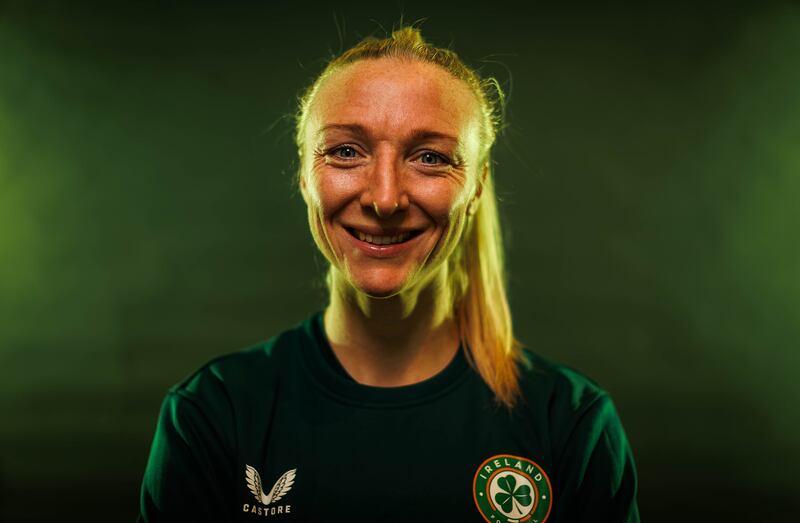
Like her long-time comrade Louise Quinn. At 22, having won it all with Dublin’s Peamount United, Quinn began to wonder if she should spread her wings and look to play abroad. She signed up with a football agency, submitted video clips to demonstrate her abilities as a defender, and waited.
Come January 2013, she was battling homesickness, the language barrier and frozen eyelashes, having been signed by Swedish club Eskilstuna United. It was a whole new world, in every way imaginable.
They say the Swedes make the worst of strangers but the best of friends. They take a while to open up. But when they do: friends for life
— Louise Quinn
She was being paid to play football. Not much, but enough to get by. That prospect would have been inconceivable when she started out with Blessington Boys aged seven.
Quinn spent three years in Sweden before moving on to England. The experience was enriching, on and off the field. “It was difficult enough at first; culturally we are quite different. They say the Swedes make the worst of strangers but the best of friends. They take a while to open up. But when they do: friends for life.”
Kyra Carusa
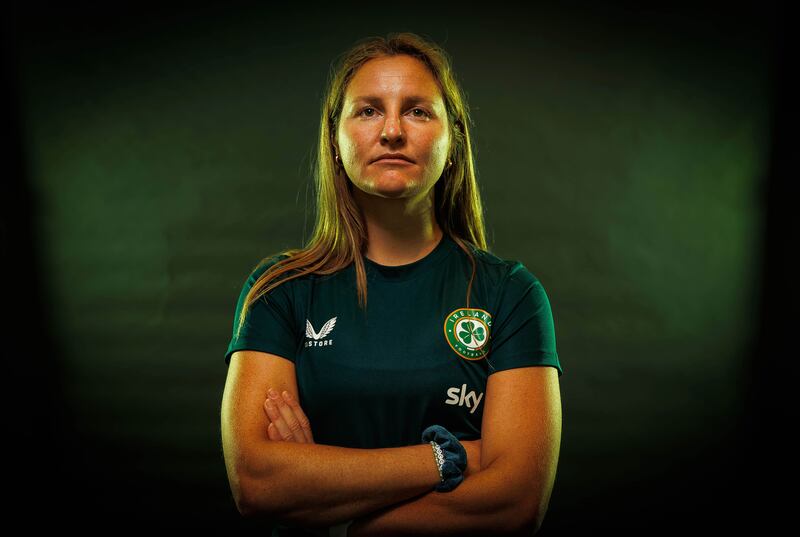
Kyra Carusa grew up in San Diego, the granddaughter of Cork man Tony Lucey and Laois woman Beryl MacCluskey, both of whom had emigrated to the States in the 1950s.
She was so promising a young player, Stanford University offered her a football scholarship when she was still recovering from a broken leg. Just a 90-minute flight up the Californian coast, it was one of the shorter journeys in her career.
The plan was straightforward enough: she would enjoy her football during her time there, but while studying human biology her ultimate aim would be to become a doctor. There was, after all, no future in football.
When the sun is out they shine like nowhere else I’ve ever seen. Except Ireland
— Kyra Carusa
On graduating, she switched to Georgetown University on the east coast to do a master’s, but by then she was beginning to reassess those plans – football might, after all, present her with an adventure or two.
The first one came in France, where she spent a short spell with Le Havre. Then along came an offer from HB Køge. Carusa was bemused. “Could I even pick Denmark out on a map?” She couldn’t. But she packed her bags again and set off for the ancient Danish seaport of Køge, 45km south of Copenhagen, with a population of just 38,000.
“It felt so, so different, a whole new world of things. The way of life, the culture, the language, the scenery, the colours – when the sun is out they shine like nowhere else I’ve ever seen. Except Ireland.”
After three successful seasons in Denmark, during which she won two league titles and a player of the year award, Carusa was on her travels again, this time moving to London City Lionesses.
“The sweetest and yet scariest goodbye,” she wrote in her farewell post in January. “HB Køge, thank you for finding me when I needed you most ... we part as good friends who have changed each other’s lives for the better. I cannot thank you enough for welcoming me with open arms. Denmark will forever be a home to me.”
Niamh Fahey
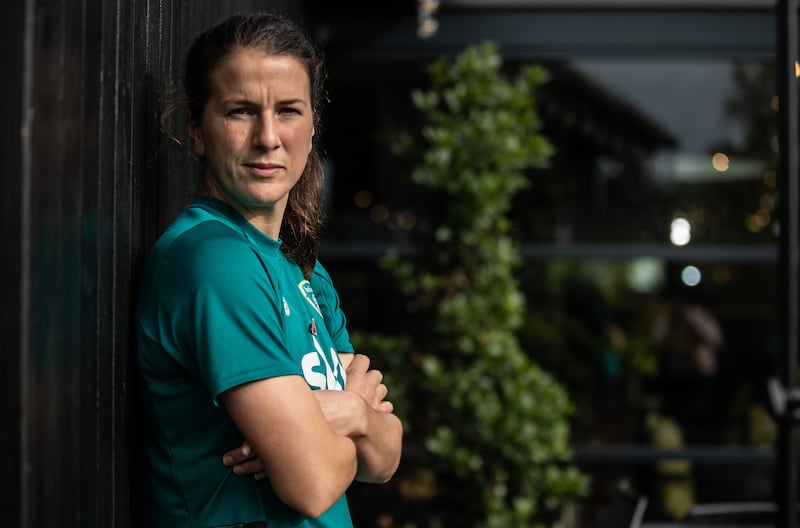
Niamh Fahey laughs when you list the countries she and the rest of the World Cup squad have made home down the years.
England, Scotland, Wales, Iceland, Norway, Sweden, Denmark, Germany, France, Italy, Spain, Cyprus, the United States and Australia. And we can add Belgium to the list soon, with Amber Barrett having signed for Standard Liege in June.
“That’s some amount of air miles,” she chuckles. “We really have got around.
“When you look back at the places so many of the players went when they first left Ireland, it shows where the opportunities were then, where we went to be able to play football at a good level and, at least, semi-professionally.
“Scandinavia back then, Norway and Sweden especially, was a real powerhouse in women’s football, and later the likes of Germany, France and Spain. And a good few of the players would have taken up football scholarships in the States too. So, we just went wherever those opportunities arose.
“The traditional route for male players from Ireland has always been to the leagues in England and Scotland, but while plenty of us went that way too, like myself, others had to look further afield. With the growth of the game in England in the last few years, more of us are playing there now – well over half the squad – but yeah, back then we ended up in all kinds of places.”
Fahey’s own sporting journey, which has taken in London, Bordeaux and Liverpool since she left home, has been quirky. At 35 she is the squad’s oldest player. When she won an All-Ireland Gaelic football title with Galway in 2004, the squad’s youngest member, Abbie Larkin, was six months away from being born.
It was three years later, when she was playing for Salthill Devon, that she made her senior debut for Ireland. Eleven months on and Ireland played a friendly against Arsenal, then reigning supreme in English women’s football, in Dublin.
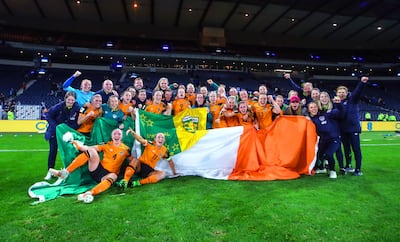
Arsenal’s legendary manager Vic Akers was so impressed with two of the Irish players that evening, he offered them contracts with the London club. Fahey accepted her offer, whereas Katie Taylor turned down hers. “I suppose it wasn’t a bad decision by Katie; she’s kind of done all right for herself,” says Fahey.
“She was super talented in football and boxing. She was just a standout player, underage, senior, the whole way up. So powerful, so fit, she could play anywhere. She was a huge loss for Irish football, but a massive gain for boxing. My God, what she’s done for that sport.”
By then Fahey was halfway through a science degree in the University of Galway, switching to the University of Hertfordshire to complete it on joining Arsenal. Much as it was a thrill to join the power that was Arsenal, the financial rewards weren’t even at subsistence levels. Back then, it was pay per play, about £80 a game, and there might have been only two in a month.
That meant the players, unless they lived locally with their families, had to find part-time jobs to pay the bills, Fahey followed in the path of Arsenal’s earlier Irish recruits – Emma Byrne, Clara Grant and Yvonne Tracey – by working in the club laundry at their training ground, where washing the underwear of the men’s team was among their tasks.
I think all of us had that realisation from the start, that football probably wouldn’t be something that would lead to a full-time career, so we couldn’t let go of our education
— Niamh Fahey
That’s where women’s football was at in the early 2000s, and, in some cases, where it remains. For all the cheery talk about the success of England’s Women’s Super League – the increased television coverage, the record attendances, and so on – the BBC reported last year that some of its players were earning as little as £20,000-a-year, about £18,000 below the average industrial wage.
So when Fifa announced in June that every player at this summer’s World Cup would be guaranteed €28,000, the figure increasing if their nations progressed through the tournament, that was no small change. For the vast majority of the 736 players included in the 32 squads, it would be considerably more than they earn with their clubs.
There’s a reason, then, that 17 of Ireland’s 23-strong World Cup squad have college degrees, with some of the others planning on resuming their education at some point. When they retire, there won’t be a fortune in the bank to keep them afloat.
“I think all of us had that realisation from the start, that football probably wouldn’t be something that would lead to a full-time career, so we couldn’t let go of our education. We needed something to fall back on when we finished playing,” says Fahey, who has an MSc in pharmacology and is also pursuing an MBA.
“In a way, it’s the opposite of the men’s game: there a lot of players might only start thinking about life after football as they’re nearing retirement; we tended to think about it from the beginning because there was no expectation that you’d either earn enough to set yourself up or that other opportunities would open up – like coaching or media work.
“But that’s changing now. In terms of post-playing opportunities, it’s the best it’s ever been. More and more players are doing their coaching badges and thinking about a future in that side of the game, and there are so many more openings now for media work as presenters or pundits with the increased amount of coverage of the game.”
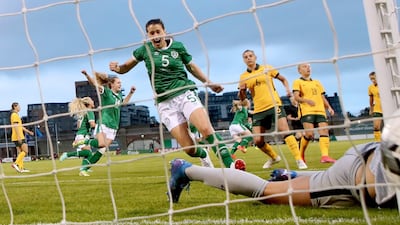
Having always intended going back to science at the end of her playing career, Fahey, who will play at least another year for Liverpool, having recently signed a new contract, is now giving some thought to staying in the game.
“With all the experiences that I’ve had, I think I’ve so much to give back now. I loved science, but I think after being involved in teams and dealing with people, it would be very hard to go back into that cold, clinical environment. The sport, working with teams: they are my passions now. So if a role arose for me, I would like to stay in sport.”
She has no regrets about all that studying, though. “Like with a lot of the players, it suited me. I liked the balance it gave me in my life. It can be a good mental distraction from the football. You have so much free time when you’re a full-time player. If I just trained and went home and had nothing else to do, I’d start thinking too much, which wouldn’t be good for me. I’m someone who needs to be distracted and kept busy, so education and football have always been a healthy balance for me.”
It’s 15 years since she left Galway for London, in that time building a career she never imagined was possible. “I went over for a year to try it out,” she laughs, “and I’m still here. I remember when I first landed in London doubting I was good enough to be there. It was nerve-racking. And I was so homesick that first year, it was difficult for me to settle.
“But you stick with it. To have had the career I’ve had, and now to be going to the World Cup with Ireland, you couldn’t have dreamt it.”
Denise O’Sullivan
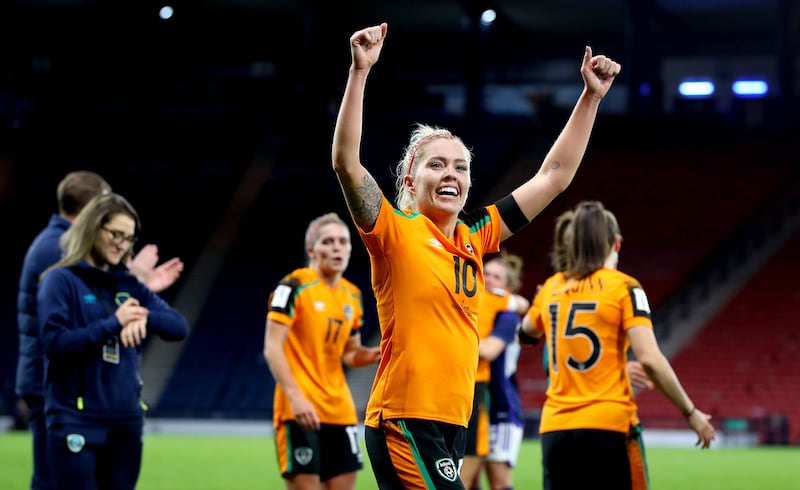
In the air miles battle, Denise O’Sullivan probably comes out on top: from Knocknaheeney, Co Cork, to Glasgow, Houston and North Carolina, with stopovers in Canberra, Sydney and Brighton.
After 2½ years with Glasgow City, her talents had outgrown the Scottish league, by then O’Sullivan looking for a bigger challenge. Her move to Houston Dash in the National Women’s Soccer League made history in 2016, it was the first time that a Scottish women’s club received a transfer fee for a player. Mind you, as the Scottish Herald reported at the time, it was only a “four-figure sum”, such was the value placed on players at the time.
It was a tumultuous spell for O’Sullivan, as she told Malachy Clerkin in this newspaper at the time. “My dad passed away on Sunday, I signed for Houston Dash on Thursday and then went to the [Football Association of Ireland] awards on Sunday and won International Player of the Year – my emotions were all over the place.”
[ Denise O’Sullivan : ‘When I told him about Houston Dash he was over the moon’Opens in new window ]
But her father, John, who died from cancer at 63, had encouraged her to go ahead with the Houston move, knowing it would give her talents the platform they deserved.
The youngest of a close-knit family of 10, she had suffered from homesickness when she moved to Glasgow as a teenager, so wasn’t quite sure how she would cope with a switch to Texas. “I had to grow up pretty quick. Obviously leaving home at that age was scary and something I had to think about, but once I left I got very independent. It’s made me a better person.”
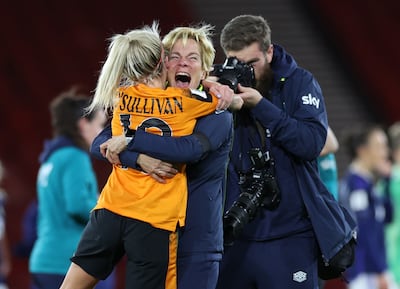
She was helped by the faith her Houston manager, Randy Waldrum, placed in her, and if you want an indication of how small the women’s football world can be, Waldrum is now the manager of Nigeria, who are in Ireland’s World Cup group.
Waldrum soon departed, though, and his replacement didn’t rate O’Sullivan. After just a year in Texas, when she was only beginning to find her feet, she was on the move again, this time to North Carolina.
In her six years there, she has developed into one of the finest midfielders in the game, winning two national league titles in that time and being made captain of the team this season.
Having conquered that challenge, she has shown no fear of taking on new ones, moving to Australia twice and to England for loan spells during the off-season in the US. When she left Australia after her first loan, the headline in the Sydney Morning Herald read: “Canberra United’s Irish superstar Denise O’Sullivan says goodbye ... she proved a sensation.”
Living the dream
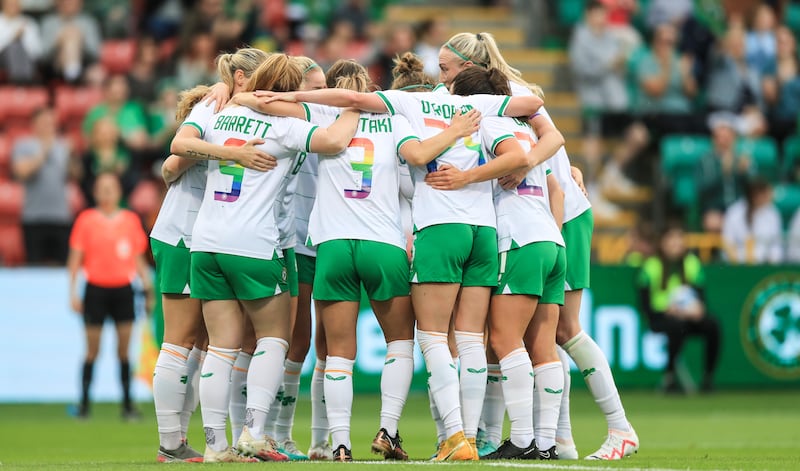
Footballers can be a little quick off the mark when it comes to publishing autobiographies. Wayne Rooney wasn’t yet 21 when his first was released in to the wild, and while he had already had five years in the spotlight by then, it still seemed a touch early to be telling his life story. Mind you, he was a veteran next to Miley Cyrus – she was 15 when she penned hers.
But when you look through the journeys that so many of this Irish World Cup squad have made through their careers, they have some stories to tell.
Megan Connolly left Turners Cross in Cork and, later, Heather Payne set sail from Creagh, Co Roscommon, to take up football scholarships in Florida State University. They are two of the seven players in the squad who came through the US college system, also among them the American-born quartet of Carusa, Courtney Brosnan, Sinéad Farrelly and Marissa Sheva.
When Claire O’Riordan left Newcastle West in Limerick to do a BA in sports management and coaching at the Institute of Technology in Carlow, she wasn’t even aware that a woman could play football for Ireland. Come 2018 she was playing professionally for MSV Duisburg in the German league, and in May she was scoring for Celtic in the Scottish Cup final in front of a crowd of 10,000 at Hampden Park, the first time the national stadium had ever hosted a women’s final.
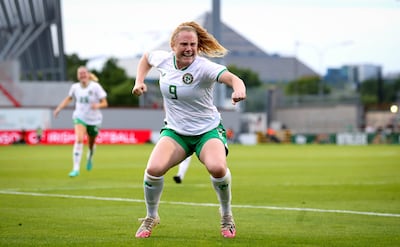
When she was captain of the Irish under-19 team, Chloe Mustaki was diagnosed with Hodgkin’s lymphoma, a gruelling recovery taking about two years. Playing in a World Cup for Ireland less than 10 years later was not in her thoughts. Getting better was her only focus. Last summer she gave up her job in investment banking and took a 50 per cent pay cut to play for Bristol City, all in the hope of making it to that World Cup. She’s on the plane.
Amber Barrett and Ciara Grant left Milford and Letterkenny, Co Donegal, respectively, after successful spells in the Irish league to play professionally in Germany and Scotland. Grant, somehow, managed to complete her medical studies along the way, and is now a fully qualified doctor.
The next destination on their winding journeys is Stadium Australia in Sydney on July 20th, where a crowd of 82,500 will watch Ireland take on their hosts in their first ever World Cup game.
It’s some story.




















